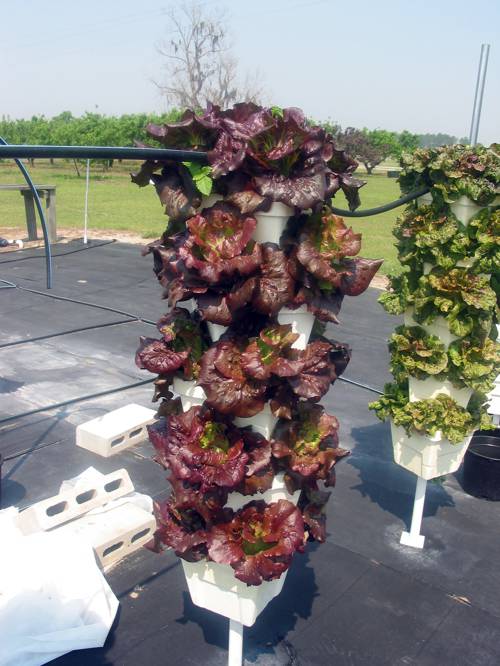
FAQ About Vertical Hydroponics for Indoor Plants

What is vertical hydroponics for indoor plants?
Vertical hydroponics is a method of growing plants without soil, using mineral nutrient solutions in water. Specifically designed for indoor use, vertical systems optimize space by stacking or layering plants vertically to maximize growth area in a small footprint.

How does a vertical hydroponic system work indoors?
A vertical hydroponic system works by circulating nutrient-rich water through a series of vertical channels or towers that hold the plants. These systems often use a pump to move the water and rely on gravity to return it to the reservoir, creating a closed-loop system that efficiently delivers nutrients to plant roots.

What types of plants are suitable for vertical hydroponics?
Many plants are suitable for vertical hydroponics, especially leafy greens like lettuce, spinach, and kale. Herbs such as basil, mint, and cilantro also thrive in these systems. Some fruiting plants like strawberries and cherry tomatoes can be grown, provided the structure supports their growth requirements.

What are the benefits of using vertical hydroponics indoors?
Vertical hydroponics offers several benefits for indoor plant cultivation, including maximizing space efficiency, faster plant growth, and reduced water usage compared to traditional soil gardening. Additionally, it allows for better pest control and less environmental impact.

Is vertical hydroponics difficult to set up at home?
Setting up a vertical hydroponic system at home can be manageable with the right tools and guidance. It involves assembling a frame or tower, setting up a water reservoir and pump system, and planting the selected crops in the provided spaces or channels. Kits are available that simplify the process for beginners.

Can you grow vegetables indoors using vertical hydroponics?
Yes, vegetables such as lettuce, kale, and herbs are commonly grown indoors using vertical hydroponics. Other vegetables like peppers and tomatoes can also be grown if the system is well-designed to provide adequate support and light.

Do vertical hydroponic systems require special lighting?
Indoor vertical hydroponic systems often require artificial lighting, such as LED grow lights, to provide the necessary light spectrum for plant growth. These lights should mimic natural sunlight and be adjustable to suit the different growth stages of the plants.

How much space is needed for a vertical hydroponics setup indoors?
The space required for a vertical hydroponics setup can vary greatly depending on the system size and the number of plants you wish to grow. Compact systems can fit in small areas, even apartments, while larger systems need more space but are still more space-efficient than traditional gardening methods.

What maintenance is required for vertical hydroponic systems?
Maintenance for vertical hydroponic systems includes regularly checking and adjusting the nutrient solution, monitoring pH levels, ensuring the water pump functions correctly, and inspecting plants for signs of pests or disease. Regular cleaning of the system components is also necessary to prevent algae growth.

How cost-effective are vertical hydroponic systems?
Vertical hydroponic systems can be cost-effective in the long run due to their efficiency in water and space usage, potentially leading to higher yields in smaller areas. Initial setup costs vary, but savings on water and the potential to grow your own food can offset these costs over time.

Are vertical hydroponic systems environmentally friendly?
Yes, vertical hydroponic systems are considered environmentally friendly because they use significantly less water than traditional gardening, reduce the need for pesticides, and minimize soil erosion. They can also be set up to use renewable energy sources for operation, further reducing their environmental impact.

What are common challenges faced in vertical hydroponics?
Common challenges in vertical hydroponics include managing nutrient levels, ensuring proper light distribution, preventing mold and algae growth, and handling structural limitations if the system is not robust. Regular monitoring and adjustments help overcome these challenges.

Can I build a DIY vertical hydroponic system?
Yes, you can build a DIY vertical hydroponic system using materials like PVC pipes, plastic bottles, or even commercially available kits. DIY systems require some technical knowledge about water circulation and plant nutrient needs but can be an economical way to start hydroponic gardening indoors.

What types of vertical hydroponic systems are there?
There are several types of vertical hydroponic systems, including tower gardens, A-frame systems, and wall gardens. Each type uses a different structure but operates similarly to allow water and nutrients to flow through the system, supporting plant growth in limited space areas.

How do vertical hydroponic systems compare with traditional soil gardening?
Vertical hydroponic systems offer several advantages over traditional soil gardening, such as greater space efficiency, faster growth cycles, and lower water usage. They also allow for year-round gardening indoors and can be less susceptible to soil-borne diseases and pests.

Do vertical hydroponic systems require much water?
Vertical hydroponic systems are designed to be water-efficient, using significantly less water than traditional soil gardening. Water is recirculated within the system, reducing overall consumption while ensuring plants receive constant access to necessary nutrients.

What are the energy requirements of a vertical hydroponic system?
The energy requirements for a vertical hydroponic system mainly pertain to the lighting (such as LED grow lights) and water pump. Energy-efficient components can help reduce the overall energy consumption, and integrating solar panels can further enhance sustainability.

Can vertical hydroponic systems be integrated with smart technology?
Yes, vertical hydroponic systems can be integrated with smart technology to automate tasks like nutrient dosing, pH monitoring, and light adjustments. Smart systems can enhance plant growth efficiency by automatically monitoring and responding to environmental changes.

What initial investment is needed for vertical hydroponics?
The initial investment for vertical hydroponics varies depending on the system size and complexity. Basic systems can be set up with a few hundred dollars, whereas more advanced setups with automated features can cost more. However, investment in hydroponic systems can lead to long-term savings in water usage and produce costs.

What supplies are essential for setting up a vertical hydroponic system?
Essential supplies for a vertical hydroponic system include a frame or tower structure, nutrient solutions, a water reservoir, a pump, and grow lights. Additional items might include pH test kits, thermometers, or humidity sensors to monitor the growing environment.
